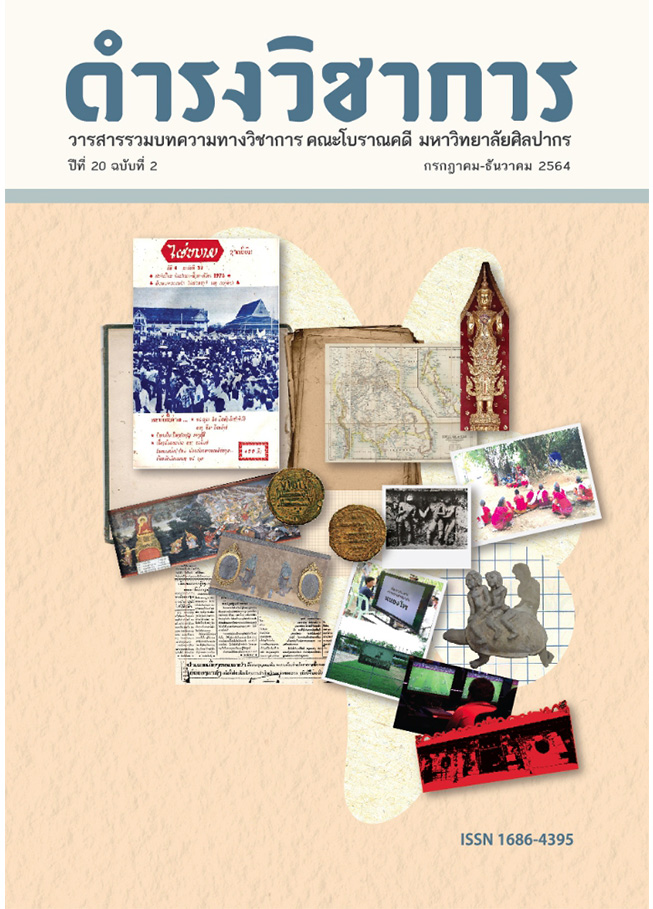Art Styles and Concepts of Shui Wei Sheng Niang Shrine, Chang Khlan Sub-district, Mueang Chiang Mai District, Chiang Mai Province, Thailand
Keywords:
Chinese Shrine, Shui Wei Sheng Niang, Hainanese, Chiang MaiAbstract
The Shui Wei Sheng Niang Shrine, in the Chang Khlan Sub-district of Chiang Mai, is a historic and famous Chinese-beliefs shrine under the patronage of Hainam Association Chiang Mai, an association of the Thai-Hainanese people - the Thai descendants of a Han Chinese group originally from Hainan Island in China and who ultimately resided in Chiang Mai Province. This research examines the art styles of the shrine as well as the concepts and influences in the architectural construction of Thai-Hainanese people in Mueang Chiang Mai. The research found that the Hainanese have different architectural styles from other Chinese groups in Southern China such as the Cantonese, the Hakka, and the Teochew, a style referred to as the Guangfu Architecture School in Hainan. Some characteristics of this unique architectural style in the ancestral land of the Thai-Hainanese have been transplanted to this Shui Wei Sheng Niang Shrine in Mueang Chiang Mai. However, the shrine also shows contemporary construction techniques, an influence taken from the art styles of other Overseas Chinese groups in Thailand, as well as the declination of their own traditional art styles, and resembling the architectural styles of the other Chinese shrines in Mueang Chiang Mai that were constructed in the same decade.
References
จิตรา ก่อนันทเกียรติ, 2545. ทำเนียบเจ้าแม่และผู้วิเศษของจีน. กรุงเทพฯ: จิตรา.
ต้วน ลี่ เซิง, 2543. ความเป็นมาของวัดจีนและศาลเจ้าจีนในประเทศไทย. (แปลโดย บุญยิ่ง ไร่สุขสิริ).
กรุงเทพฯ: คณะกรรมการศาสนาเพื่อการพัฒนา.
ประทีป มาลากุล, ม.ล., 2530. พัฒนาการบ้านของคนไทยในภาคกลาง. กรุงเทพฯ: จุฬาลงกรณ์
มหาวิทยาลัย.
เมธิพงศ์ รุจิระศิริกุล, 2564. “รูปแบบงานประติมากรรม และความเชื่อที่ศาลเจ้าแม่ทับทิม ตำบลช้างคลาน
อำเภอเมืองเชียงใหม่ จังหวัดเชียงใหม่.” ใน การประชุมวิชาการบัณฑิตศึกษาระดับชาติ ครั้งที่ 11
เรื่อง วิจัยและนวัตกรรมเพื่อเตรียมพร้อมรับการเปลี่ยนแปลง (H13-H20). กรุงเทพฯ: บัณฑิต
วิทยาลัย มหาวิทยาลัยศิลปากร, 24-25 มิถุนายน 2564.
วิลเลียม จอร์จ สกินเนอร์, 2529. สังคมจีนในประเทศไทย: ประวัติศาสตร์เชิงวิเคราะห์. (แปลโดย พรรณี
ฉัตรพลรักษ์ และคณะ). กรุงเทพฯ: มูลนิธิโครงการตำราสังคมศาสตร์และมนุษยศาสตร์.
ประวัติศาลเจ้าแม่ทับทิม, ม.ป.ป. แผ่นป้ายของศาลเจ้าแม่ทับทิม. เชียงใหม่: ศาลเจ้าแม่ทับทิม.
สรัสวดี อ๋องสกุล, 2552. ประวัติศาสตร์ล้านนา. พิมพ์ครั้งที่ 6. กรุงเทพฯ: อมรินทร์.
หวัง ยี ชุน, 2557. ประวัติการอพยพของชาวจีนไหหลำ (2 เล่ม). (แปลโดย สันติ วยากรณ์วิจิตร และ ยรรยง
กัยวิกัย). กรุงเทพฯ: มูลนิธิการศึกษาและวัฒนธรรมไหหลำแห่งประเทศไทย.
อชิรัชญ์ ไชยพจน์พานิช, 2557. สถาปัตยกรรมศาลเจ้าจีนในกรุงเทพฯ ช่วงพุทธศตวรรษที่ 24-25: ภาพ
สะท้อนตัวตนคนจีนในสังคมไทยสมัยรัตนโกสินทร์. กรุงเทพฯ: คณะโบราณคดี มหาวิทยาลัย
ศิลปากร.
____________, 2558. “โครงสร้างรับน้ำหนักแบบชาเหลียงในศาลเจ้าและภาพสะท้อนชาวจีนอพยพใน
กรุงเทพฯ สมัยรัชกาลที่ 1-5.” Veridian E–Journal, Silpakorn University ฉบับภาษาไทย
สาขามนุษยศาสตร์ สังคมศาสตร์ และศิลปะ 8 (2): 2491-2508.
____________, 2560. เทพเจ้าในศาลเจ้าจีนกรุงเทพมหานคร: รูปแบบ คติการสร้าง และความสัมพันธ์
กับชุมชนชาวจีน. นครปฐม: สถาบันวิจัยและพัฒนา มหาวิทยาลัยศิลปากร.
____________, 2561. ศาลเจ้าจีนในกรุงเทพฯ. กรุงเทพฯ: มติชน.
สัมภาษณ์
ประธานคณะกรรมการบริหารศาลเจ้าแม่ทับทิมจังหวัดเชียงใหม่. สัมภาษณ์โดยผู้เขียน. 21 ตุลาคม 2564.
สงวน ภู่เจริญไพศาล. สัมภาษณ์โดยผู้เขียน. 21 ตุลาคม 2564.
Downloads
Published
Issue
Section
License
บทความนี้เป็นผลงานของข้าพเจ้าแต่เพียงผู้เดียว และ/หรือเป็นผลงานของข้าพเจ้าและผู้ร่วมงาน ตามชื่อที่ระบุในบทความจริง และเป็นผลงานที่มิได้ถูกนำเสนอหรือตีพิมพ์ที่ใดมาก่อน


